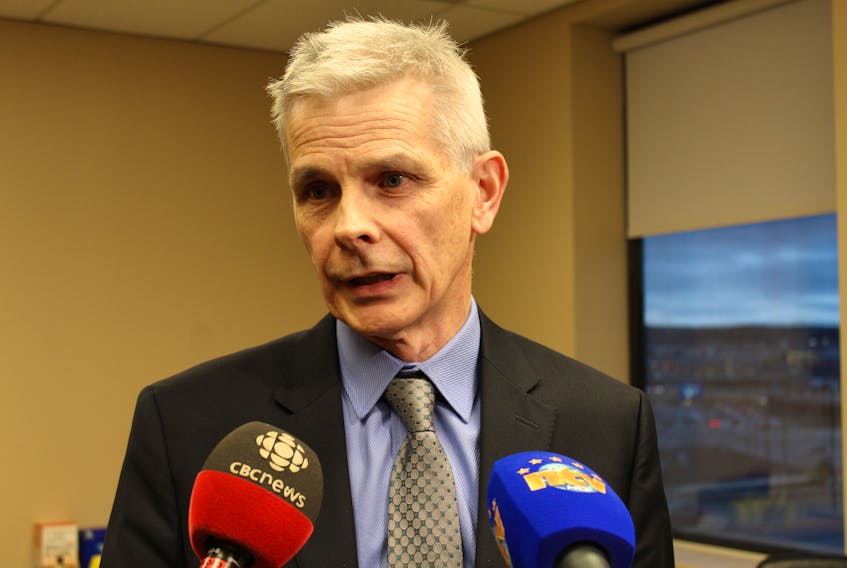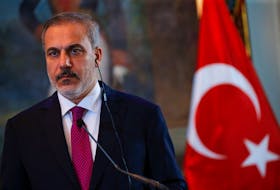A line has been drawn.
On one side sits a collection of former provincial government members and top bureaucrats, while on the other side are representatives from Nalcor Energy, with the issue being the full disclosure of costs for the Muskrat Falls project.
Robert Thompson, a former deputy minister of natural resources and former clerk of the executive council, was back on the stand at the Muskrat Falls Inquiry in St. John’s on Thursday. He was asked again about a reported $500-million amount for “strategic risk” not being included in the public cost estimate, as noted by auditors with Grant Thornton.
Lawyer Dan Simmons, representing Nalcor Energy, referred Thompson to a document in evidence, also on file with the Public Utilities Board from its review including Muskrat Falls, stating the assessment of risk and mitigation of risk continued at both the “tactical and strategic” levels at the time. The PUB’s final report in 2011 states Westney Consulting recommended a “strategic reserve” and the idea would be assessed again, with the final cost estimates. The “strategic risk” concept was communicated to the government, Simmons suggested, and he put to Thompson that related reports — with estimated dollar figures — could have been requested.
“That’s an accurate statement,” Thompson said.
Lawyer Harold Smith, representing former Nalcor Energy president and CEO Ed Martin, later challenged the very reality of the $500-million figure (actually, $497 million) repeatedly being discussed before the inquiry, saying the view was very different by the time the project was sanctioned.
Thompson already testified about detailed discussions happening between Crown corporation and government officials about different items of risk that could contribute to cost overruns. It included the potential for labour shortages and the rate of work required on the powerhouse. Smith described compensation offered for workers, and “early works” started in 2011 in Labrador.
The work to mitigate risk that followed the assessments, he said, would have changed things, including the dollar estimate for strategic risk.
“We keep talking about $497 million. No one really knows whether that $497 million existed at the time of the sanction of the project, do they?” Smith asked Thompson.
Thompson said he didn’t know if the same risks existed or not, but he believes the government should still have been involved in more discussion involving the dollar figure offered earlier by Westney Consulting.
Former deputy finance minister Terry Paddon previously testified he wasn’t aware of the number at all and it should have been available to the public.
Lawyer Geoff Budden, representing the Concerned Citizens Coalition, asked Thompson about the “cold eyes” reviews of Nalcor Energy. He also asked about a report from Validation Estimating LLC in April 2012.
Former deputy project general manager Jason Kean previously testified that Nalcor Energy made use of only a partial quote from the report in subsequent presentations on the project, one not including the reservations expressed about project risk. That’s in addition to the report only having been a draft document.
Thompson said he remembered seeing the partial quote.
“I can’t recall ever seeing that report,” he said, later saying he relied on Nalcor Energy to provide, as Budden put it in his questions, the “straight goods” on project reviews.
Lawyer Andrew Fitzgerald, representing former associate deputy minister Charles Bown, asked more about the communication of project details to the government, referring to public documents mentioning “strategic reserve” and risk.
“We wouldn’t expect Nalcor to rely upon the department to ferret out that detail (on ‘strategic risk’) and bring it up for discussion. If it’s an important issue, we would rely upon Nalcor to frame it up for some of these briefings,” Thompson said.
On Wednesday, he mentioned a “blizzard of activity” in the lead-up to sanctioning of the Muskrat Falls project in 2012. And on Thursday he said there was a need for important information to be pulled out by Ed Martin and other leaders at Nalcor Energy, to allow for detailed discussion before decisions were made.
But in response to questions from John Hogan, representing the Consumer Advocate, Thompson said — regardless of what was said about strategic risk, tactical risk or contingent equity required from government — the province was also going to have to pay for any cost overruns on the project.
Thompson said he looks forward to finding out more about why the project went so far beyond the original cost and schedule estimates.
The second phase of the inquiry, to be completed in early 2019, will delve more into the construction costs.
Richard Westney from Westney Consulting, the company reporting the $500-million amount estimated for strategic risk, is scheduled to be on the stand Friday.
Twitter: @TeleFitz
RELATED STORIES:
Province maintained oversight of Muskrat Falls, former bureaucrat says









